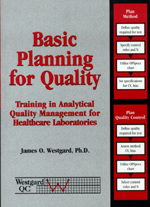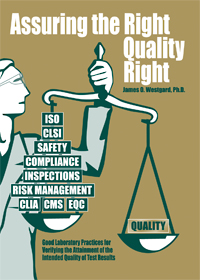Basic Planning for Quality
QP-13: Coagulation Applications
Many laboratorians commonly think that QC theory is only for chemistry. Not true! The Quality Planning process can be applied to any test - and here's the proof for coagulation analytes like Prothrombing Time, Partial Thromboplastin Time, and Fibrinogen. (Preview)
- Quality requirements
- Method imprecision and inaccuracy
- Example applications
- Planning and implementation strategies
I've saved the best till last! Here are some quality-planning applications for coagulation tests performed on an automated coagulation analyzer that provides three levels of controls and on-line support for data calculations, display of control charts, and flagging by selected QC rules. Looks like an automated chemistry analyzer to me, which makes it easy to apply similar planning and implementation strategies!
Quality requirements
CLIA includes criteria for acceptable performance for three coagulation tests in its hematology category:
- Prothrombin time Target value +/- 15%
- Partial thromboplastin time Target value +/- 15%
- Fibrinogen Target value +/- 20%
Method imprecision and inaccuracy
The example tests presented here are being performed by an automated coagulation analyzer. Routine QC data are available from four different control materials. One material is used for all three tests, two materials are used only for PT and PTT, and one material is used only for fibrinogen.
- Material 1 CVPT=2.6%, CVPTT=2.3%, CVfibrinogen=3.2% (at 273 mg/dL)
- Material 2 CVPT=3.3%, CVPTT=2.3%
- Material 3 CVPT=3.7%, CVPTT=2.6%
- Material 4 CVfibrinogen=5.2% (at 96 mg/dL)
The average CV for PT is 3.2%, the average CV for PTT is 2.4%, and the average CV for fibrinogen is 4.2%.
The laboratory has two of the automated coagulation analyzers, which are routinely compared to minimize any biases between them. Therefore, for practical purposes, the inaccuracy can be considered as zero.

 We invite you to read the rest of this article
We invite you to read the rest of this article
Note: This material is covered in the Basic Planning for Quality manual, which is availalbe in our online store. You can download the Table of Contents and additional chapters here.
Updated and expanded coverage of these topics can be found in Assuring the Right Quality Right,also available in our online store. You can also download the Table of Contents and additional chapters here.
Finally, you can access materials online on these topics by enrolling in the Management and Design of Analytical Quality Systems course course.
